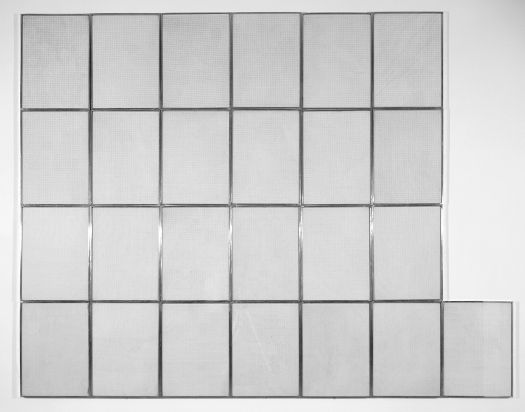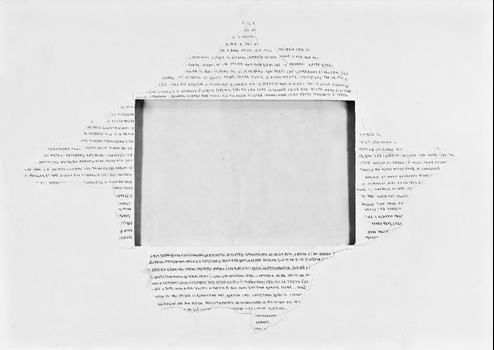
Cimento dell’armonia e dell’invenzione (Contest of Harmony and Invention), 1969
Pencil on graph paper
Each: 27 9/16 x 19 11/16″ (70 x 50 cm) Overall approximately: 114 3/16 x 141 3/4″ (290 x 360 cm) Private collection. Courtesy 1000 Eventi Gallery, Milan
© 2012 Estate of Alighiero Boetti / Artists Rights Society (ARS), New York / SIAE, Rome
Somewhere in America this morning, someone took a coffee capsule and placed it in a single-cup Kuerig coffee maker, pressed a button, and got a fresh cup of coffee. Meanwhile, somewhere else in America, someone poured whole coffee beans into a grinder, ground up the coffee, and then meticulously scooped out the proper amount into a filter basket, be it a drip coffee maker or percolator, and then waited for the coffee to brew. Still somewhere else, someone ground beans, measured them into a French press pot while heating water in another receptacle, and then combined ground coffee and water into the press pot, let it steep for several minutes, and then pressed. Which of these methods of making coffee — just three of many — would you say is more artful? I’m going to guess the Kuerig option is not your first choice, even though it’s the most efficient.
The connection between art and efficiency occurred to me while recently visiting the Alighiero Boetti exhibit, Game Plan, at the Museum of Modern Art (MOMA). Boetti (1940–1994) lived in Turin, Italy, and in the early 1960s became one of the leading artists of the Arte Povera movement, exemplified by his sculptural works made of everyday materials, including wood, cardboard, and aluminum. It’s Boetti’s later works, though, that I found most fascinating. “Painstaking” is a word that comes up often in describing his work. He was obsessed with the concepts of nonaction and inefficiency, especially as a response to the industrial and technological advances in Italy. He titled works “Giving Time to Time” and “Bringing the World into the World.”

Tapestry. 128 x 76″ (325.1 x 193 cm). Dallas Museum of Art. Fractional Gift of the Rachofsky Collection © 2012 Estate of Alighiero Boetti/Artists Rights Society (ARS), New York/SIAE, Rome
Take for example L’albero delle ore (Tree of Hours) from 1979. This large tapestry measures 128” x 76,” and is based on a drawing in which he symbolically recorded the chimes of Santa Maria in Trastevere, a church in Rome, as they rang on the quarter hour from midday to midnight. According to MOMA’s description of the piece, he thought the resulting shape resembled a tree and initially called the drawing I pino non crescono in un gi(o)urno (The pine tree doesn’t grow in a day). The symbols are embroidered vertically in white thread against a ground of the same white thread embroidered horizontally. The piece is one of many that’s purpose is to make time and its passing visible. Time, Boetti insisted, “is the only thing that is really magical.” However, his use of time as a medium was often extravagant; he “wasted” it or used it as inefficiently as possible, “in a conflation of laziness and laborious but unnecessary effort.”
In Clessidra, cerniera e vice versa (Hourglass, Hinge and Vice Versa) from 1981, Boetti uses pencil on paper and his left hand – he was right-handed — to transcribe thoughts about time and its passage because it forced him to write slowly and therefore be more conscious of his thought process.
In yet another piece, Cimento dell’armonia e dell’invenzione (Contest of Harmony and Invention) from 1969, Boetti uses a pencil to trace lines on graph paper, drawing each line in a different manner, from a different angle, with a different hand, etc.
If Boetti’s aesthetic was a response to industrial and technological advances, are the artisans of today doing the same thing and responding to ever present smartphones and apps and an obsession with efficiency? Efficiency is not necessarily a bad thing. Time is limited after all, and being able to pay your bills or reserve movie tickets with a few clicks is a beautiful thing.
Think about some of the people here in Nashville making things, especially those new ones that are getting the most local and national attention. There’s Imogene + Willie, Las Paletas, Barista Coffee Parlor, Peter Nappi Boots, Olive and Sinclair Chocolate Co. and Otis James Handcrafted Tie company, to name a few. Nashville institution Hatch Show Print has been making posters the same ways for dozens of years. None of these purveyors of goods are necessarily doing things in the most efficient way. Yet, we would all consider them artisans of some degree. The people at McDonalds make burgers, and they do so very efficiently, assembly-line like. You can get a burger in seconds. If you order a burger at Gabby’s, or Burger Up or the Pharmacy, it’s going to take awhile. It’s very inefficient. Depending on your taste, all three of the locally-owned restaurants, as well as McDonalds, make delicious burgers. Only their approaches are different.

Pencil on Paper. 27 9/16 x 39 3/8″ (70 x 100 cm). Courtesy Galleria Alessandra Bonomo, Rome © 2012 Estate of Alighiero Boetti/Artists Rights Society (ARS), New York/SIAE, Rome
Let’s carry it one step further. There is plenty of music being made and recorded in Nashville. Much of it recorded directly into ProTools or other digital recording tools, and mixed and mastered down “in the box.” It’s outputted to .Mp3s or other formats and put up online. Entire records can be recorded and released in days, even the same day. And yet there are those artists using much older tools, recording on tape, and releasing records on vinyl. Sometimes the records are released in limited editions, with handcrafted covers, sold only at shows or local stores. I would think this is a highly inefficient way to release music in 2012. Which of these artists, the ones recording “in the box” or the ones using what seems like antiquated techniques do you consider truly more “artistic?” Why?
It’s almost as if the words “artisanal” and “artistic” can be interchanged with “inefficient.” But if art and creativity truly is about process, is doing things the inefficient way, since it inherently takes longer, more artistic? What then of Warhol’s print work? Can doing things efficiently be also artful?
An additional question. If we are living in a time obsessed with efficiency (see Timothy Ferriss’ bestselling The 4-Hour Workweek) is it art’s job to remind us that sometimes faster or more efficient is not always better. Sometimes, as in the work of photographer Edward Burtynsky, currently on view in the Gordon CAP Gallery at the Frist Center, or filmmaker Jennifer Baichwal, that connection is obvious. Other times, as in Warhol’s print work, it’s not.
What do you think?

